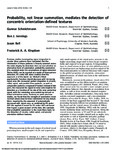Probability, not linear summation, mediates the detection of concentric orientation-defined textures
| dc.contributor.author | KANG, JUNGHEE | |
| dc.contributor.author | Jennings, BJ | |
| dc.contributor.author | Bell, J | |
| dc.contributor.author | Kingdom, FAA | |
| dc.date.accessioned | 2017-11-16T17:36:31Z | |
| dc.date.available | 2017-11-16T17:36:31Z | |
| dc.date.issued | 2015-12-07 | |
| dc.identifier.issn | 1534-7362 | |
| dc.identifier.issn | 1534-7362 | |
| dc.identifier.other | ARTN 6 | |
| dc.identifier.uri | http://hdl.handle.net/10026.1/10191 | |
| dc.description.abstract |
Previous studies investigating signal integration in circular Glass patterns have concluded that the information in these patterns is linearly summed across the entire display for detection. Here we test whether an alternative form of summation, probability summation (PS), modeled under the assumptions of Signal Detection Theory (SDT), can be rejected as a model of Glass pattern detection. PS under SDT alone predicts that the exponent β of the Quick- (or Weibull-) fitted psychometric function should decrease with increasing signal area. We measured spatial integration in circular, radial, spiral, and parallel Glass patterns, as well as comparable patterns composed of Gabors instead of dot pairs. We measured the signal-to-noise ratio required for detection as a function of the size of the area containing signal, with the remaining area containing dot-pair or Gabor-orientation noise. Contrary to some previous studies, we found that the strength of summation never reached values close to linear summation for any stimuli. More importantly, the exponent β systematically decreased with signal area, as predicted by PS under SDT. We applied a model for PS under SDT and found that it gave a good account of the data. We conclude that probability summation is the most likely basis for the detection of circular, radial, spiral, and parallel orientation-defined textures. | |
| dc.format.extent | 6-6 | |
| dc.format.medium | ||
| dc.language | en | |
| dc.language.iso | eng | |
| dc.publisher | Association for Research in Vision and Ophthalmology (ARVO) | |
| dc.subject | texture detection | |
| dc.subject | glass pattern | |
| dc.subject | global processing | |
| dc.subject | probability summation | |
| dc.subject | linear summation | |
| dc.subject | additive summation | |
| dc.subject | Signal Detection Theory | |
| dc.subject | high threshold theory | |
| dc.title | Probability, not linear summation, mediates the detection of concentric orientation-defined textures | |
| dc.type | journal-article | |
| dc.type | Journal Article | |
| dc.type | Research Support, Non-U.S. Gov't | |
| plymouth.author-url | https://www.webofscience.com/api/gateway?GWVersion=2&SrcApp=PARTNER_APP&SrcAuth=LinksAMR&KeyUT=WOS:000368253000006&DestLinkType=FullRecord&DestApp=ALL_WOS&UsrCustomerID=11bb513d99f797142bcfeffcc58ea008 | |
| plymouth.issue | 16 | |
| plymouth.volume | 15 | |
| plymouth.publication-status | Published | |
| plymouth.journal | Journal of Vision | |
| dc.identifier.doi | 10.1167/15.16.6 | |
| plymouth.organisational-group | /Plymouth | |
| plymouth.organisational-group | /Plymouth/Faculty of Health | |
| plymouth.organisational-group | /Plymouth/Faculty of Health/School of Health Professions | |
| plymouth.organisational-group | /Plymouth/REF 2021 Researchers by UoA | |
| plymouth.organisational-group | /Plymouth/REF 2021 Researchers by UoA/UoA03 Allied Health Professions, Dentistry, Nursing and Pharmacy | |
| plymouth.organisational-group | /Plymouth/Research Groups | |
| plymouth.organisational-group | /Plymouth/Research Groups/Institute of Health and Community | |
| plymouth.organisational-group | /Plymouth/Users by role | |
| plymouth.organisational-group | /Plymouth/Users by role/Academics | |
| dc.publisher.place | United States | |
| dc.identifier.eissn | 1534-7362 | |
| dc.rights.embargoperiod | Not known | |
| rioxxterms.versionofrecord | 10.1167/15.16.6 | |
| rioxxterms.licenseref.uri | http://www.rioxx.net/licenses/all-rights-reserved | |
| rioxxterms.type | Journal Article/Review |


